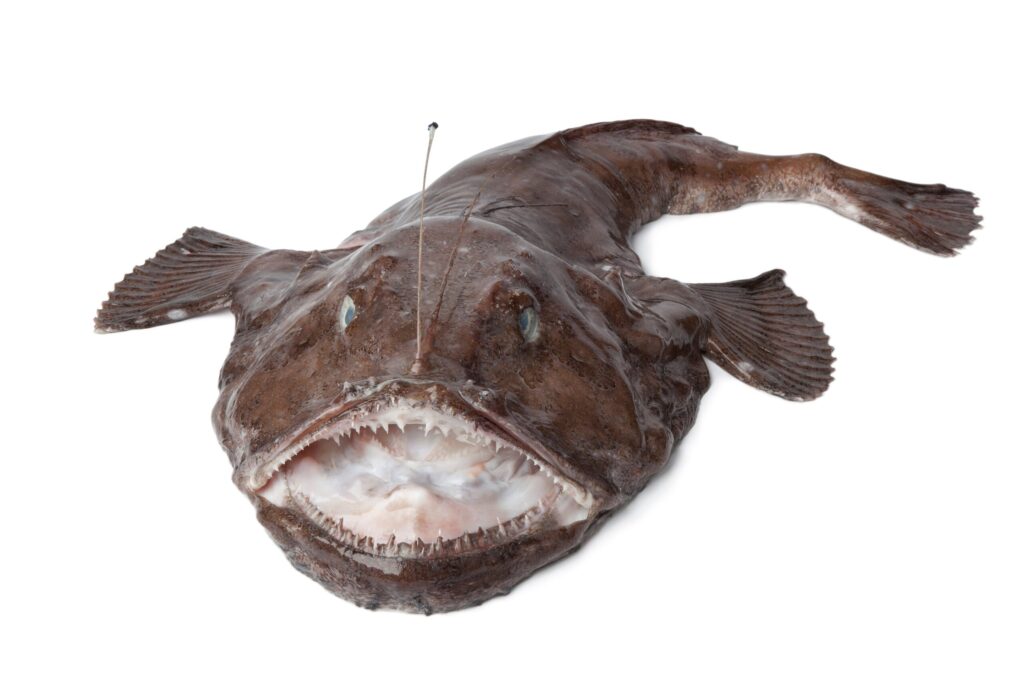
Anglerfish, with their eerie glow and unusual appearance, have captured the imagination of many. These fascinating creatures inhabit the depths of our oceans, where they’ve evolved unique adaptations to survive in a harsh environment. While not commonly found on dinner plates worldwide, anglerfish are considered a delicacy in certain cultures, prized for their delicate flavor and sustainable nature. This article delves into the world of anglerfish, exploring their biology, habitat, culinary uses, and the challenges associated with sourcing this rare seafood.
This exploration will cover the distinctive features of anglerfish, their mesmerizing bioluminescent lures, the extreme depths they call home, and how different cultures incorporate them into their cuisine. We’ll also examine the sustainability aspects of anglerfish fishing and the hurdles faced in making this unique seafood more accessible.
Anglerfish Biology and Appearance
Anglerfish belong to the order Lophiiformes, a diverse group encompassing over 200 species. They are characterized by their elongated bodies, large mouths filled with sharp teeth, and most notably, a fleshy appendage called an illicium protruding from their head. This illicium acts as a fishing rod, tipped with a bioluminescent lure that attracts unsuspecting prey in the dark depths of the ocean.
Anglerfish exhibit sexual dimorphism, meaning males and females have distinct physical characteristics. Females are significantly larger than males, often reaching lengths of several feet. Males, on the other hand, are much smaller and parasitic, attaching themselves to a female’s body for nourishment. This unique mating strategy ensures the survival of the species in their challenging environment.
Bioluminescent Lures
The anglerfish’s most striking feature is undoubtedly its bioluminescent lure. This fleshy appendage, located above the fish’s mouth, dangles enticingly like a fishing rod, adorned with a glowing tip that attracts prey in the pitch-black depths of the ocean. The light produced by the lure is generated through a symbiotic relationship with bioluminescent bacteria housed within specialized organs called photophores.
These bacteria convert chemical energy into light, creating a mesmerizing glow that can be seen from considerable distances. Anglerfish can control the intensity and color of their lure, mimicking the movements of small crustaceans or other prey to lure unsuspecting victims closer. This ingenious adaptation allows them to thrive in an environment where visibility is limited.
Deep Sea Habitat
Anglerfish are denizens of the deep sea, inhabiting waters that plunge hundreds to thousands of meters below the surface. These extreme environments are characterized by crushing pressure, frigid temperatures, and perpetual darkness. Anglerfish have evolved remarkable adaptations to survive these harsh conditions.
Their bodies are streamlined and flexible, allowing them to navigate through dense currents and rocky terrain. Their large eyes are adapted for detecting faint light sources in the deep sea, while their sensitive lateral lines help them detect vibrations and movements of prey. The anglerfish’s ability to withstand immense pressure and thrive in complete darkness makes it a true marvel of evolution.
Culinary Uses and Cultural Significance
While not widely consumed globally, anglerfish holds a special place in the culinary traditions of certain cultures. In Japan, for example, anglerfish is considered a delicacy known as “angler fish” or “anakago.” It’s often served grilled, steamed, or deep-fried, prized for its delicate flavor and firm texture.
In other regions, anglerfish is used in soups, stews, and even sushi. The unique taste and appearance of anglerfish have made it a popular ingredient among adventurous foodies seeking to explore new culinary horizons. However, due to their limited availability and the challenges associated with sourcing them sustainably, anglerfish remains a rare treat for most.
Sustainability and Sourcing Challenges
Anglerfish are generally considered a sustainable seafood option. Their deep-sea habitat means they are not subject to the same overfishing pressures as many commercially important fish species found in shallower waters. However, sourcing can you eat angler fish sustainably presents several challenges.
Deep-sea fishing practices can have unintended consequences for other marine life and ecosystems. Additionally, the remote nature of anglerfish habitats makes it difficult to monitor fishing activities and ensure responsible harvesting practices. Consumers interested in enjoying can you eat angler fish should seek out reputable suppliers who prioritize sustainability and ethical sourcing methods.
Conclusion
Anglerfish are fascinating creatures that have adapted to thrive in one of Earth’s most extreme environments. Their unique biology, bioluminescent lures, and culinary significance make them a subject of both scientific interest and gastronomic curiosity. While can you eat angler fish remains a rare treat for many, its sustainable nature and distinct flavor offer a glimpse into the wonders of the deep sea. As we continue to explore and understand our oceans, it’s crucial to ensure that these remarkable creatures are protected and sustainably managed for generations to come.
